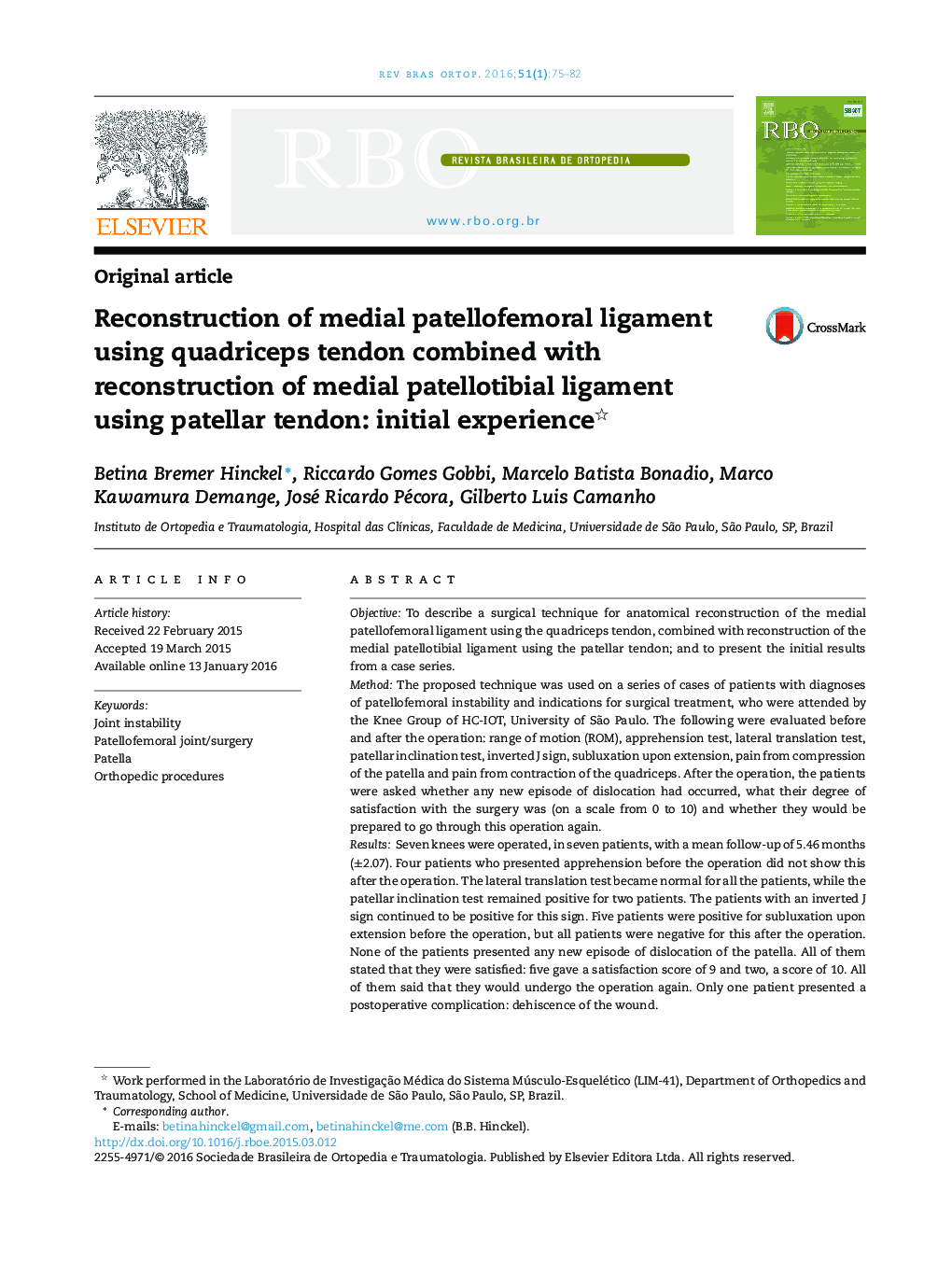| کد مقاله | کد نشریه | سال انتشار | مقاله انگلیسی | نسخه تمام متن |
|---|---|---|---|---|
| 2713440 | 1145157 | 2016 | 8 صفحه PDF | دانلود رایگان |

ObjectiveTo describe a surgical technique for anatomical reconstruction of the medial patellofemoral ligament using the quadriceps tendon, combined with reconstruction of the medial patellotibial ligament using the patellar tendon; and to present the initial results from a case series.MethodThe proposed technique was used on a series of cases of patients with diagnoses of patellofemoral instability and indications for surgical treatment, who were attended by the Knee Group of HC-IOT, University of São Paulo. The following were evaluated before and after the operation: range of motion (ROM), apprehension test, lateral translation test, patellar inclination test, inverted J sign, subluxation upon extension, pain from compression of the patella and pain from contraction of the quadriceps. After the operation, the patients were asked whether any new episode of dislocation had occurred, what their degree of satisfaction with the surgery was (on a scale from 0 to 10) and whether they would be prepared to go through this operation again.ResultsSeven knees were operated, in seven patients, with a mean follow-up of 5.46 months (±2.07). Four patients who presented apprehension before the operation did not show this after the operation. The lateral translation test became normal for all the patients, while the patellar inclination test remained positive for two patients. The patients with an inverted J sign continued to be positive for this sign. Five patients were positive for subluxation upon extension before the operation, but all patients were negative for this after the operation. None of the patients presented any new episode of dislocation of the patella. All of them stated that they were satisfied: five gave a satisfaction score of 9 and two, a score of 10. All of them said that they would undergo the operation again. Only one patient presented a postoperative complication: dehiscence of the wound.ConclusionReconstruction of the medial patellofemoral ligament using the quadriceps tendon, combined with reconstruction of the medial patellotibial ligament using the patellar tendon, was technically safe and presented good objective and subjective clinical results in this case series with a short follow-up.
ResumoObjetivoDescrever técnica cirúrgica de reconstrução anatômica do LPFM com tendão quadricipital combinada com a reconstrução do LPTM com tendão patelar e apresentar os resultados iniciais em uma série de casos.MétodoFoi aplicada a técnica proposta em uma série de casos de pacientes do Grupo de Joelho do HC-IOT diagnosticados com instabilidade patelofemoral e com indicação de tratamento cirúrgico. No pré e pós-operatório foram avaliados: amplitude de movimento (ADM), teste da apreensão, teste da translação lateral, teste da inclinação patelar, sinal do J invertido, subluxação em extensão, dor a compressão da patela e dor a contração do quadríceps. No pós-operatório também foi perguntado aos pacientes se houve novo episódio de luxação, qual o grau de satisfação com a cirurgia (escala de zero a 10) e se passariam pela cirurgia novamente.ResultadosForam operados sete joelhos em sete pacientes e a média de seguimento foi de 5,46 meses (±2,07). Tivemos quatro pacientes com apreensão no pré-operatório que não tinham apreensão no pós-operatório. O teste de translação lateral foi normalizado em todos os pacientes enquanto o teste da inclinação patelar permaneceu positivo em dois pacientes. Os pacientes com J invertido permaneceram com o sinal positivo. A subluxação em extensão, presente no pré-operatório em cinco pacientes, foi negativa em todos no pós-operatório. Nenhum paciente apresentou novo episódio de luxação da patela. Todos responderam estar satisfeitos. Cinco pacientes referiram satisfação 9 e dois referiram 10. Todas passariam novamente pela cirurgia. Apenas uma paciente apresentou complicação pós-operatória, deiscência de ferida.ConclusãoA reconstrução combinada do LPFM com tendão quadricipital com a reconstrução do LPTM com tendão patelar é tecnicamente segura e apresentou bons resultados clínicos objetivos e subjetivos nesta série de caso de curto seguimento.
Journal: Revista Brasileira de Ortopedia (English Edition) - Volume 51, Issue 1, January–February 2016, Pages 75–82